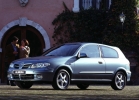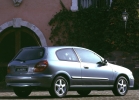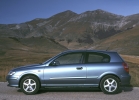Crash Test Nissan Almera (Pulsar) 3 Doors 2000 - 2002 Hatchback
Crash test Nissan Almera (Pulsar) 3 doors 2000, 2001, 2002: Laboratory car safety assessment: Rating in points, test report (photo and video crash test)
26%
Driver and passengers
16%
Pedestrians
Protection of the driver and passenger
 Frosting, driver |
 Front punch, passenger |
 Side blow, driver |
|
Children's holding devices
| Child up to 18 months | Roemer Peggy, face forward |
| Child older than 3 years | Roemer King, face forward |
Pedestrian safety
 |
|
Comments:
Almera spoke in the test worse than her close relative Tino. The car "distinguished" the worse driver's defense, especially in the field of chest and legs. However, the overall result is no worse than others, but in comparison with the previous generation Almera noticeable great progress.Front punch:
The body is significantly deforated, so it is difficult to predict how he behaves in a more serious collision. Airbags for both front sediments are included in the basic bundle. Although there are plates in the steering column to protect the driver, they are not enough to prevent damage at a tough collision. The front seat belts are equipped with pretensioners that reduce the risk of damage. The central seat of the seat of the seats is equipped with a three-point inertial seat belt, providing better protection compared to static waist.Security of passenger children:
Rearmost seat belts are designed for fixing children's chairs. This is reported on three languages, fixed on the belt itself. A warning about the front passenger safety pillow on the visible side of the sunscreen visor is clear, however it can easily break away. The manufacturer recommended using the Römer King chairs for 3-year and Römer Peggy for a 18-month passenger installed "in the direction of movement". Only such chairs are compatible with seat belts. The Römer King chair was unreliable fastened by the belt, allowing the passenger's head to approach the dangerous distance to the traumatic elements in the cabin. The 18-month passenger turned out to be protected better, although the experts noted the high burden on the neck, usually occurring for the chairs established "in the direction of movement".Side strike:
Side airbags for breasts and heads provided an appropriate level of protection at side shocks about overlapping and a pillar, although they did not completely reveal. The abdominal department of the driver suffered from contact with the armrest.Pedestrian safety:
The front edge of the hood and the bumper provided weak pedestrian foot protection. The hood softened the blow to the places where the child's head falls.General information about the car
| Roelf location | Left |
| Tested model | Nissan Almera 1.5 Luxury |
| Body type | 5-door hatchback |
| Year of publishing data | 2001 |
| Curb weight | 1238 |
| The results are valid for VIN, starting with ... | SJN *** N16U0141700. |
Installation Systems:
| Pretensels of front seat belts | There is |
| Front Belts Load Loaders | There is |
| Driver Front Airbag | There is |
| Passenger Front Airbag | There is |
| Side airbags | There is |
| Side Head Airbags | There is |
| Driver's knees and feet airbag | No |











